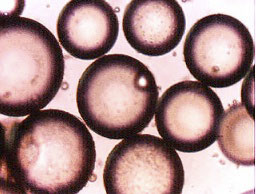In the field of anti-ubiquitin antibodies many solutions are available on the market. But LifeSensors, a company specialized in Ubiquitin research field, have developped a monoclonal antibody called VU-1. Available in Europe only through tebu-bio, it’s recognised as the most efficient solution in terms of ubiquitin detection for Elisa, Western Blot and IHC applications.
Ubiquitin (Ub), a highly conserved, 8 kDa polypeptide is present in all eukaryotic cells. Thanks to the action of three enzymes, E1 (Ub activating enzyme), E2 (conjugating enzyme) and E3 (ligase), ubiquitin is conjugated to the ε-amino group of lysine residues in the target protein. In addition, the seven lysines within Ub itself can serve as Ub acceptors leading to the formation of polyubiquitin chains. Among these, K48 and K63 linkages are well characterized. K48-linked polyubiquitylation targets proteins for proteasomal degradation, whereas K63 linkages regulate signaling events, receptor endocytosis and immune responses. Polyubiquitin linkages at other lysines are less prominent and their physiological role remains largely unknown.

Developped by LifeSensors, VU-1 is one of the most efficient monoclonal antibodies that has been shown to recognize free ubiquitin, K48-, K63-, K11- and linear chains in many applications. Another important point to notice is that
reactivity is independent of species due to the high conservation of ubiquitin across eukaryotes.

(A). K48, K63 and K11-linked polyubiquitin conjugates;
(B). 40 µg HEK293T cell lysate (50 nM Bortezomib treated);
(C).OLN cells untreated (Ctr) and treated with 1 µM MG132. Cell lysates were separated on SDS-PAGE and immunoblotted with VU-1 antibody (B.1 µg/ml; C.0.2 µg/ml).
Western Blot
VU-1 is an excellent mAB to detect different proteins modified by poly- and mono-ubiquitin, linear ubiquitin chains, and free ubiquitin in cell lysate as shown in figure 1.
In 2015, Dr J.Gidla et al investigated the best Ubiquitin detection antibodies for Western Blot (1). Among more than five commercial Ubiquitin detection antibodies, VU-1 appears as the best performing one for ubiquitin detection in mouse heart and liver cytosolic fractions.
ELISA

Unconjugated ubiquitin was coated on polystyrene plates, blocked and incubated with either VU-1 or FK2 antibodies (1µg/ml) followed by anti-mouse HRP conjugate (1:5000). After adding ECL the plate was read using Envision plate reader.
Unconjugated Ubiquitin can also be detected by ELISA. After incubation of both VU-1 and FK-2 detection antibodies, analysis of the results show that a better and more accurate detection of unconjugated ubiquitin is performed with VU-1 mAB in comparison to FK-2 antibody (Fig. 2)
Immunostaining

(Progressive Supranuclear Palsy, PSP). Paraffin embedded, formalin fixed 6 µm sections were stained with MAb VU‐1 (1:1000) after antigen retrieval. To block autofluorescence, tissue sections were treated with Sudan black.
The VU-1 mAb is also an excellent antibody for immunostaining applications, generating robust ubiquitin detection and low background with an ability to detect subcellular ubiquitin localization. As shown Fig.3, Ubiqutin is detected in Human brain tissue and co-localized with Tau-labelled human neurons. More immunostaining data with VU-1 mAB on transfected Myoblasts, or methanol fixed OLN93 cells are available in the datasheet.
Ultimately, VU-1 mAB from LifeSensors is a robust, sensitive and accurate solution for your Ubiquitin detection.
Contact our specialists at your local tebu-bio office for more details on this antibody.
You might also like to take a look at all the other innovative solutions from LifeSensors, and in particular the TUBEs technology for efficient purification of poly-ubiquitined proteins.
References:



